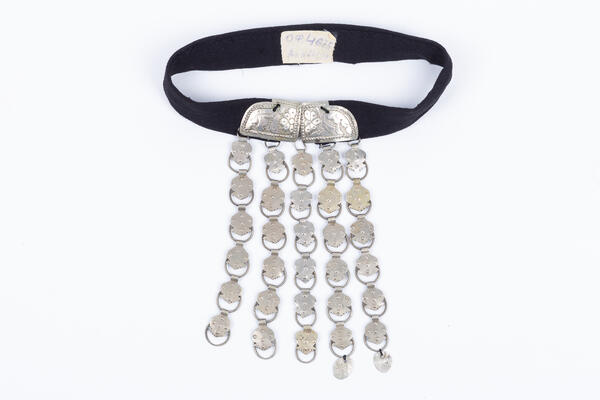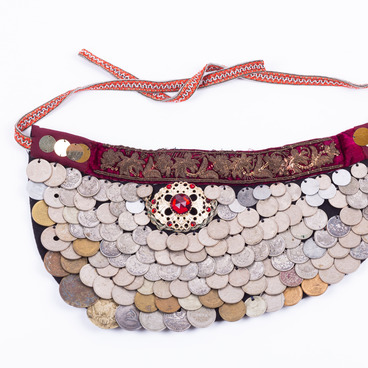The museum exhibition displaces an old tatar collar necklace, a yaka chylbyry. The name can be translated as ‘a collar chain, ’ or ‘a necklace.’ This jewelry was usually made as a pendant with chains connected with buckles. The buckles were fixed on thick brocade collars worn over a dress. They were not sewn to the clothes but fixed under a collar.
The buckles could be of various shapes: leaves, round, rectangular with side festoons, rosettes, diamonds, spatulate, fan-shaped, and like a Turkish cucumber.
A classic accessory featured five chains with rosette-shaped or leaf-shaped plates. The chains were connected with rings. However, a jewelry could consist of rings only. End pendants were fixed at chain ends: metal plaques, drop-shaped or oval stones in frames, coins, most often those were ‘curly’ rubles produced in the period of Catherine the Great.
Yaka chylbyry were richly decorated. It beautifully covered the whole chest of the owner and was a noticeable detail of the costume: shiny, sparkling and shimmering.
Collar chains were often beaten, or filigree, less often cast. A jewelry could combine both beaten and filigree elements. The accessory appearance mainly depended on the owner’s taste and her financial position.
Scientists could not identify at what age women wore this jewelry: nowadays, it is no longer worn. Yet scientists assume that young girls or young women purchased these necklaces. Only wealthy city dwellers could afford buying the expensive accessory.
Collar necklaces traditionally covered low necklines on clothes, like a woman’s shirt, or a dress. At the turn of the 20th century, girls started using fashionable brooches-pins to cover plunging necklines. Gradually they stopped wearing yaka chylbyrys.
The buckles could be of various shapes: leaves, round, rectangular with side festoons, rosettes, diamonds, spatulate, fan-shaped, and like a Turkish cucumber.
A classic accessory featured five chains with rosette-shaped or leaf-shaped plates. The chains were connected with rings. However, a jewelry could consist of rings only. End pendants were fixed at chain ends: metal plaques, drop-shaped or oval stones in frames, coins, most often those were ‘curly’ rubles produced in the period of Catherine the Great.
Yaka chylbyry were richly decorated. It beautifully covered the whole chest of the owner and was a noticeable detail of the costume: shiny, sparkling and shimmering.
Collar chains were often beaten, or filigree, less often cast. A jewelry could combine both beaten and filigree elements. The accessory appearance mainly depended on the owner’s taste and her financial position.
Scientists could not identify at what age women wore this jewelry: nowadays, it is no longer worn. Yet scientists assume that young girls or young women purchased these necklaces. Only wealthy city dwellers could afford buying the expensive accessory.
Collar necklaces traditionally covered low necklines on clothes, like a woman’s shirt, or a dress. At the turn of the 20th century, girls started using fashionable brooches-pins to cover plunging necklines. Gradually they stopped wearing yaka chylbyrys.



